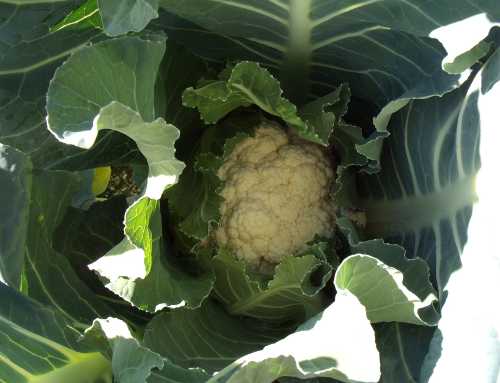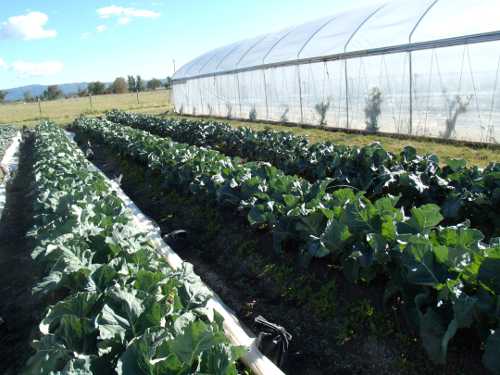
This week’s title is a reference to a quote by Mark Twain: “Cauliflower is nothing but cabbage with a college education.”
If the witty Mr. Twain meant that advanced degrees won’t alter humble roots, he may not be too far from the truth.
Cauliflower is a descendant of wild cabbage native to the coastal regions of western and southern Europe.
Along with relatives such as cabbage, broccoli, collards, Brussels sprouts, kale, bok choy, radishes and mustard, cauliflower is a member of the family of plants known as brassicas, all containing powerful phytochemicals that possess proactive health benefits.
Plants from this genus are sometimes called cole crops, a term derived from the Latin word for stem or cabbage. They’re also known as cruciferous vegetables because of the resemblance their four-petaled flowers bear to a Greek cross.
The head of the cauliflower, composed of bunches of tiny florets on clusters of stalks, is known as the curd. (Appropriate, in my opinion, because of its resemblance to curds formed in cheese making.)
Cauliflower draws its name from the Latin word for cabbage, “caulis,” and flower, a nod to its unique place in a family of plants known mainly for their green leafiness.
In addition to the creamy white color we commonly see, there are cauliflower varieties that sport lime green, purple or orange heads. Colored cauliflower is generally sweeter and more strongly flavored than its white cousins, and the orange variety has the added benefit of being rich in beta-carotene.
As a cold weather crop, cauliflower is generally available in the fall and winter; however, a spring crop is grown in mild climates and should be available at local farmers’ markets.
The best cauliflowers are those consumed within a few days of picking, making these venues perfect spots for purchase. If you can find a head still surrounded with its large, protective leaves, all the better.
Because of its delicate taste, cauliflower works well when paired with foods with strong flavors, such as pungent cheeses, garlic, curry, mustard, lemon, pepper, cumin, anchovies and the like.
In contrast to this, it’s also a favorite with rich, comforting ingredients like cream, butter and mildly-flavored cheeses for applications such as a casserole with béchamel sauce, steamed florets with a cheesy topping or baked with butter and bread crumbs.
Roasted cauliflower is a favorite treat of mine, ranking right up there with gooey chocolate desserts. The process of roasting brings out an amazingly sweet nutty flavor and there’s nothing like it.
While I enjoy roasted cauliflower as is, it may be pureed (on its own or with potatoes) for an especially comforting yet healthy food. Using cauliflower in mashed potatoes adds nutrition and reduces the amount of carbohydrates consumed. A dab of hearty mustard, garlic or sharp cheese is a nice addition to the mixture.
Roasted cauliflower may be pureed for thickness with mild white beans, such as cannelloni, and used as a spread – either warm or cold, on toasted slices of baguette.
When pureed and heated with a bit of broth, roasted cauliflower makes a creamy and flavorful soup. It can be finished, if desired, with some half and half or cream, but that’s not a necessity.
A simple sauce of Dijon mustard, lemon juice and sour cream or yogurt is a perfect way to dress up lightly-steamed cauliflower. These flavors also work when making a dip for raw cauliflower florets.
One of the most creative uses of cauliflower I’ve seen is to boil it with broccoli until very tender, and then further cook the veggie pair with olive oil, garlic, thyme, a bit of reserved cooking water and, if desired, a few hot peppers until tender enough to mash.
This mixture is then piped into tubes of uncooked cannelloni pasta, which are baked until tender in a white sauce with basil and mozzarella cheese. My mouth is watering just thinking of it.

Cauliflower is popular in Indian cooking, and an especially tasty take on this cuisine is to fry them after dipping in a batter seasoned with curry and cumin.
A unique cooking method to achieve maximum creaminess is to use milk, either dairy or almond, as a medium for gently cooking the florets on the stove top.
Cauliflower is an excellent source of vitamins C and K, contains an array of other vitamins and minerals and is a good source of dietary fiber. It has antioxidant, anti-inflammatory and detoxifying benefits and is a very good source of omega 3 fatty acids.
The phytonutrients present in cauliflower as a member of the brassica family provide a variety of health benefits, including protection against heart disease, cancer and diabetes.
A powerful cancer-fighting phytonutrient, sulforaphane, is responsible for the unpleasant smell that cauliflower and its vegetable cousins emit when cooking; however, its positive health benefits far outweigh that unpleasantness.
When buying cauliflower, choose heads that are firm with compact florets. Stay away from those which have developed brown spots on the curd. The surrounding leaves should be green with no sign of yellowing.
Cauliflower may be stored, unwashed and uncooked, in the fridge for 3 to 5 days when tightly wrapped. Cooked cauliflower will generally keep for 1 to 3 days.
Today’s recipe is a basic one for roasting cauliflower, simple yet immensely delicious, an important one to have in your repertoire. Grating fresh Parmesan cheese on the finished product is optional. Enjoy!
Roasted cauliflower
1 head of cauliflower, rinsed and patted dry
2 or 3 cloves of garlic, peeled and coarsely minced
Lemon juice from half a lemon
Extra virgin olive oil
Coarse salt and freshly ground black pepper
Fresh Parmesan cheese for grating, optional
Preheat oven to 400 degrees F.
Cut cauliflower into florets and put in a single layer in an oven-proof baking dish.
Toss in the garlic.
Squeeze lemon juice over the cauliflower, drizzle each piece with olive oil, and sprinkle with salt and pepper.
Roast cauliflower in the oven, uncovered, for 25 – 30 minutes, or until the top is lightly brown. The cauliflower should be soft and fork tender.
Remove from oven and sprinkle generously with Parmesan, if desired.
Serve immediately.
Makes about four servings.
Esther Oertel, the “Veggie Girl,” is a culinary coach and educator and is passionate about local produce. Oertel teaches culinary classes at Chic Le Chef in Hidden Valley Lake, Calif., and The Kitchen Gallery in Lakeport, Calif., and gives private cooking lessons. She welcomes your questions and comments; e-mail her at This email address is being protected from spambots. You need JavaScript enabled to view it..
Follow Lake County News on Twitter at http://twitter.com/LakeCoNews , on Facebook at http://www.facebook.com/pages/Lake-County-News/143156775604?ref=mf and on YouTube at http://www.youtube.com/user/LakeCoNews .